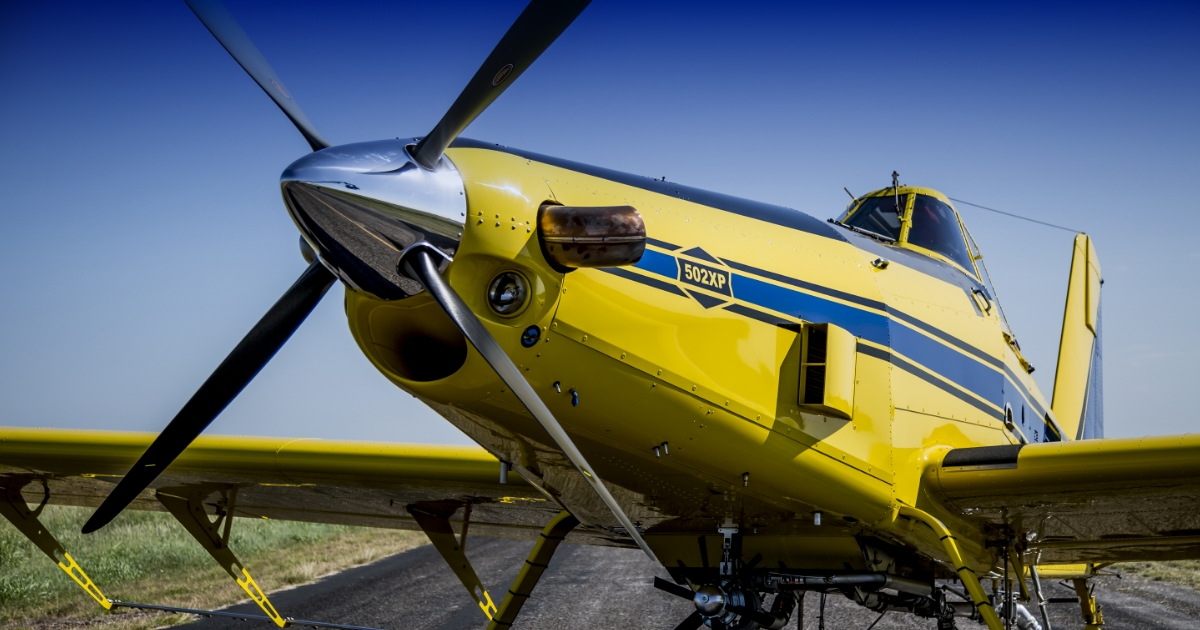
General aviation is vital to so many aspects of our lives — including the food we eat! The agricultural aviation industry supports farmers in providing a safe, affordable, and abundant supply of food, as well as fibers and bioenergy.
Each year, ag pilots treat 127 million acres of cropland, a feat only made possible by dependable, purpose-built aircraft equipped with precision application technology.
Today, we’re highlighting the industry leader in ag aircraft manufacturing and our longtime partner, Air Tractor, now celebrating 50 years of innovation in agricultural aviation.
The first documented aerial application (“crop dusting”) began as an experiment just over 100 years ago. On August 3, 1921, Army test pilot Lt. John A. Macready took off from McCook Field in Ohio in a modified Curtiss JN-6 “Super Jenny” to demonstrate an aerial crop dusting over a nearby Catalpa tree grove. The experiment worked, and an entire industry was born to support farmers.
Before and after WWII, ag planes were mostly modified military aircraft purchased from the surplus market, such as the open-cockpit Stearman biplane. In 1950, the first plane built specifically for agricultural aviation, the Ag-1, made its first flight. While the Ag-1 never sold commercially, its rugged design influenced the advanced ag aircraft to come.
Air Tractor founder Leland Snow was a pioneer and visionary in the agricultural aviation industry. In 1951, the 23-year-old Snow debuted his ag plane design, the S-1. He flew the S-1 on dusting and spraying jobs in the Texas Rio Grande Valley and in Nicaragua until 1957.
Snow would go on to design two more models in Olney, Texas, before selling his company to Rockwell-Standard. This led to the development of the Model S-2R, called the Thrush.
After resigning from Rockwell-Standard in 1970, Snow devoted his time to designing a new and improved, modern ag airplane with a sleek, aerodynamically efficient airframe. Construction began on the first Air Tractor AT-300, which later became the AT-301. In 1977, Air Tractor introduced its first turbine model, the AT-302.
As Air Tractor states, the AT-302 was “the right aircraft at the right time.” The game-changing aircraft combined Snow’s knowledge of agricultural aircraft and ag spraying with a more powerful and reliable turbine engine that could hold more payload.
According to the National Agricultural Aviation Association, the introduction of turbine engines “increased the cruising speed of agricultural aircraft by 20 mph or greater and allowed the hopper capacity to increase 75% from the largest piston-powered aircraft.”
Fifty years later, Air Tractor’s manufacturing facilities are still based in Olney, where the company produces a line of eight aircraft that includes 400, 500, 600, and 800-gallon capacity airplanes powered by Pratt & Whitney Canada turboprop engines. The powerful, capable aircraft are designed to maximize safety, reliability, and efficiency.
Air Tractor aircraft can be found in more than 40 countries around the world. In addition to their essential role in agriculture, these aircraft are used to fight wildfires, haul fuel, and supplies to remote villages, fight locust plagues, control mosquitos for public health, and even clean up oil spills in coastal waters.
Air Tractor and Hartzell Propeller share a legacy of innovation and a commitment to safety in the aviation industry. Much like aerial aerobatics, ag flying is technically demanding, requiring tremendous skill and training in rugged, unpredictable environments. At Hartzell, we’ve worked closely with Air Tractor to develop precision-performance propellers that ag pilots can rely on when flying extremely low and fast over farm fields or forests.
So, whether you’re spraying crops, seeding fields, or firefighting, our purpose-built propellers are designed to maximize your Air Tractor’s capabilities, ensuring you get the job done right every time.
Learn more about Air Tractor and the company’s 50-year legacy of innovation in agricultural aviation.